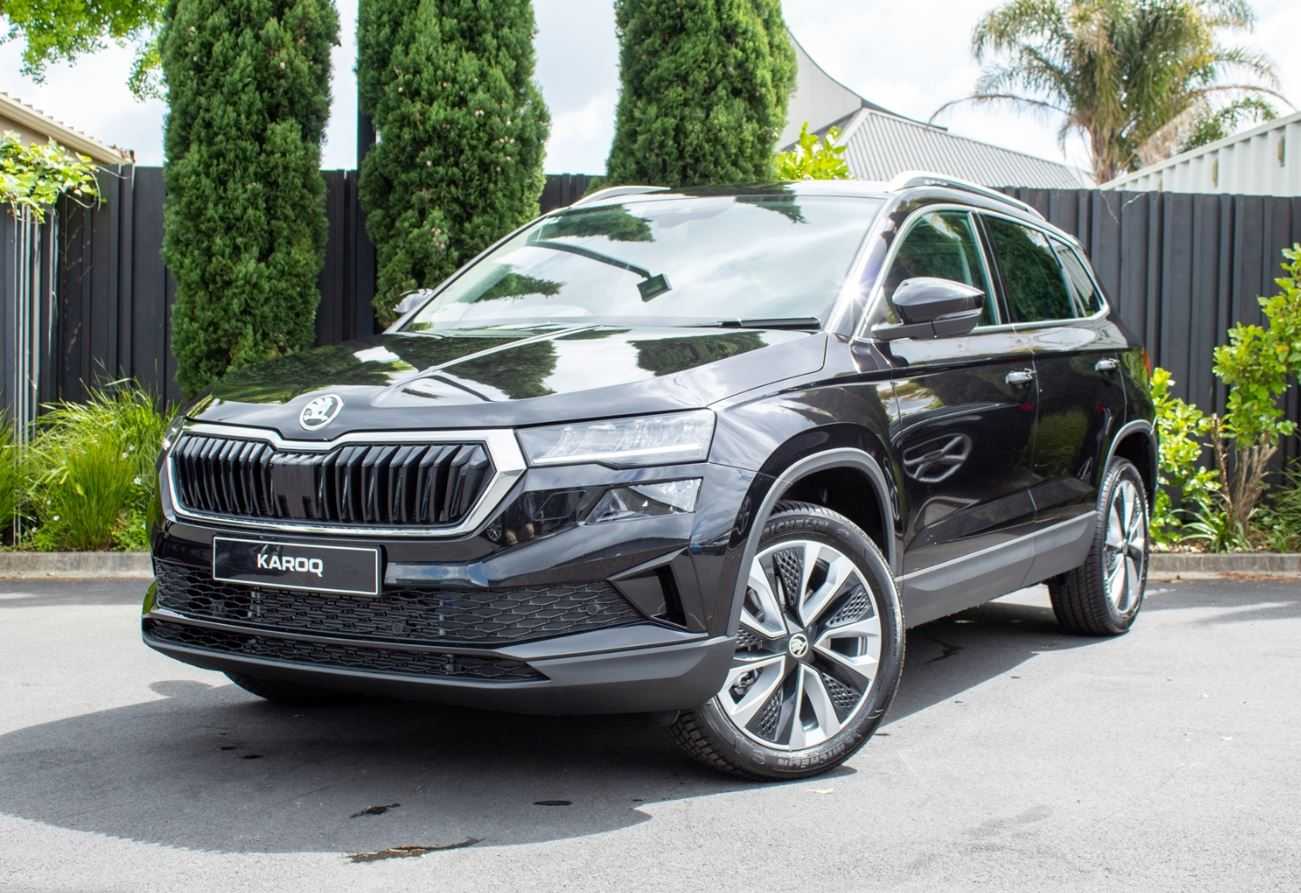2023 Skoda Karoq
The Skoda Karoq is a compact SUV that made its debut in 2017 as a replacement for the Yeti. It has been widely praised for its practicality, spaciousness, and strong driving performance. As of now, there is no official information regarding a new Karoq model for the 2023 model year. Skoda may, however, introduce some updates or changes to the current model in the future. To stay informed on any news or updates related to the Skoda Karoq, it’s recommended to monitor Skoda’s official website and social media accounts, as well as various automotive news sources.
Explanations
Digital Instructions in Vehicle Infotainment
Application Quick Start Guide Interactive images
In the pictures with the outside of the vehicle and the inside of the vehicle, there are touch points. Tapping a touch point displays a menu with topics or a detailed image.
Symbols
Information about symbols can be shown on the instrument cluster display. By tapping the symbol, a detailed description is displayed.
Topics
The instruction content is organized according to topics.
The top bar of the displayed topic
- Title of the topic
- Type of information displayed / display menu with information
- Text search
About the instructions
Language selection for instructions and updates.
Introductory notes for correct use
- Read this Owner’s Manual carefully, as proceeding in accordance with this manual is a prerequisite for the correct use of the vehicle. This Owner’s Manual should therefore always be in the vehicle.
- When using the vehicle, the generally binding legal provisions that are specific to the country must be observed. Such as those for transporting children, switching off airbags, using tyres, road traffic and the like.
- Do not exceed the maximum permissible weights and loads.
- Do not exceed the maximum permissible roof load.
- Use the specified fuel and operating fluids.
- Drive on roads that meet the technical vehicle parameters.
- Obstacles that exceed the ground clearance of the vehicle » page 238 can damage the vehicle when driving over them.
- Care must be taken during operations related to operation, maintenance and self-help to avoid damage to the vehicle or injury. If required, seek the help of a specialised garage.
- All work on the vehicle’s safety systems may only be carried out by a specialist garage. This concerns e.g. the seat belts or the airbag system.
- When using accessories, please note the instructions in the accessory manufacturer’s instruction manual. These include child seats, roof racks, compressors etc.
Please note the service intervals.
- New vehicle or new parts New vehicle – Running in the engine Driving style during the first 1500 km determines the quality of the engine run-in process.
- During the first 1000 km, rev the engine to the max. 3/4 of the highest permissible engine speed and avoid using a trailer.
Over the next 500 km, the engine speed can be slowly increased. Depending on driving style and operating conditions, the engine consumes some oil, up to 0.5 l/1000 km. Consumption may be higher over the next 5000 km.
New brake pads
New brake pads do not provide the optimum braking effect during the first 200 km, they have to be worn first. Therefore, drive very carefully.
New tires
New tires do not have optimum grip for the first 500 km. Therefore, drive very carefully.
Improper vehicle adjustments
Improper changes and maintenance can cause malfunctions and affect safety-relevant and other functions of the vehicle.
- Adjustments, repairs, and technical changes to the vehicle should only be carried out by a specialist garage.
- Never cover the engine with additional insulation material, e.g. with a cover.
Keep sensors and cameras functional Some functions of your vehicle are supported by sensors and cameras inside and outside the vehicle. Accessories additionally installed on the vehicle rear, such as bicycle carriers, can impair the functioning of the sensors and cameras. - Do not cover or stick over the sensors and cameras and keep them clean.
- If you suspect damaged sensors or cameras, seek the help of a specialist company.
Engine compartment
Before opening the engine compartment flap Risk of scalding! Do not open the engine compartment flap if steam or coolant comes out of the engine compartment.
- Stop the engine and allow it to cool.
- Remove the ignition key. On vehicles with a keyless locking system, open the driver’s door. When working in the engine compartment
- Keep children away from the engine compartment.
- Do not touch the radiator fan. The radiator fan can turn itself on, even when the ignition is off.
- Do not touch electrical cables. Avoid short circuits in the electrical system, especially on the 12 Volt vehicle battery.
- Do not smoke near the vicinity of the engine and refrain from handling open flames or sparks.
- If you need to work in the engine compartment with the engine running, be mindful of rotating engine parts and electrical equipment.
- Do not leave any objects in the engine compartment.
Handling operating fluids
Your vehicle uses various operating fluids to operate that can affect health or the environment when they are emitted. These are fuel, oils, battery acid from the 12-volt vehicle battery, coolant and brake fluid or AdBlue®.
- Only use operating fluids outdoors or in well-ventilated areas. If required, wear protective equipment.
- Do not use or check operating fluids with the engine running.
- In the event of contact with operating fluids, wash affected areas with warm water. If required, seek medical help.
- The leaked engine oil in the engine compartment can cause a fire, so wipe it off with a cloth.
- Store clothes soiled by brake fluids in a well-ventilated place until disposal. Cloths with residues of engine oil can ignite and cause a fire.
volt vehicle battery
Handling the 12-volt vehicle battery The battery acid of the 12-volt vehicle battery is very caustic. Improper handling of the 12-volt vehicle battery can cause an explosion, fire, chemical burns, or poisoning!
- When handling the 12-volt vehicle battery, eye and skin protection must be worn.
Do not tilt the 12-volt vehicle battery, as it may leak battery acid. - If battery acid comes into contact with the skin, wash the affected areas with water for a few minutes. Seek medical assistance without delay.
- Do not charge a frozen or thawed 12-volt vehicle battery. Replace a frozen 12-volt vehicle battery.
- Do not use a damaged 12-volt vehicle battery.
- Short circuit! The battery poles of the 12-volt vehicle
- The battery is not connected.
- Use electrical sockets in the vehicle
- Improper handling of the sockets may lead to life-threatening electric shock or fire.
- The sockets can become warm during operation.
- Do not touch warm sockets.
- Protect sockets from liquids.
- If moisture does manage to get into the power socket, completely dry out the socket before reuse.
- Do not insert any objects into the socket contacts.
Before your journey
Adults and children, cargo and objects – everything
has its place in the vehicle. Observe the following instructions
so that all occupants are protected in the
best possible way in the event of an accident.
Before you go
- Ensure that you have a good view of outside the vehicle. Attach external devices (e.g. navigation system) so that they do not restrict the view externally.
- Adjust the rearview mirrors.
- Close all doors and the engine compartment and boot flap.
- Take up the correct sitting position, adjust the seats correctly, and fasten the seat belt properly.
- Ensure that passengers do likewise. Always leave the seat belt on while driving.
- Only one person can be secured with a seat belt.
- Make sure that the seat belts are not trapped, e.g. in the door or in the seat.
- Check seat belts, their locks, and attachment points for damage.
Sitting safely
For the safety of the occupants and to reduce the risk of injury in the event of an accident, the following instructions must be observed:
- Stand the backrests upright. If the front passenger seat backrest has been folded forward, only the seat behind the driver’s seat may be used for transporting passengers.
- Engage the rear seat backrests correctly.
- Adjust the height-adjustable headrest so that the top of the headrest is as close as possible to the top of the head.
- On the occupied rear seat, the headrest should not be in the lower position although the upper edge of the headrest should be at the same height as the top of the head.
- Keep your feet in the footwell.
- Use the entire seat.
- Do not lean forward or sit to the side.
- Do not hold your limbs out the window.
For vehicles with driver’s knee airbags, adjust the driver’s seat longitudinally so that the distance B from the legs to the dash panel in the area of the knee airbag is at least 6 cm. Adjust the angle of the backrest so that the steering wheel can be reached at the top with your arms slightly bent. Move the passenger seat back as far as possible. The front passenger must maintain a minimum distance of 25 cm from the dash panel.
FAQ
A1: The Skoda Karoq 2023 is a compact crossover SUV designed to offer a versatile and practical driving experience.
A2: No, the Skoda Karoq was initially introduced in 2017, so the 2023 model may feature updates and refinements.
A3: The Skoda Karoq typically accommodates five passengers with its two-row seating configuration.
A4: The Skoda Karoq may offer a range of gasoline, diesel, and potentially hybrid powertrains, providing various options for performance and efficiency.
A5: Yes, the Skoda Karoq is often praised for its practicality, featuring ample cargo space and clever storage solutions.
A6: The Skoda Karoq 2023 typically features a touchscreen infotainment system ranging from 6 to 9 inches, depending on the trim level.
A7: Yes, the Skoda Karoq often offers smartphone integration through systems like Apple CarPlay and Android Auto.
A8: Yes, the Skoda Karoq may offer a range of driver assistance features, including adaptive cruise control, lane departure warning, and more.
A9: Yes, the Skoda Karoq often offers a panoramic sunroof that enhances the interior ambiance and provides an open-air feel.
A10: Yes, the Skoda Karoq may offer all-wheel drive as an option for enhanced traction and stability.
A11: The Skoda Karoq typically offers both manual and automatic transmission options, depending on the market and trim level.
A12: Yes, the Skoda Karoq is known for its spacious cabin, offering comfortable seating for both front and rear passengers.
A13: The Skoda Karoq often comes equipped with safety features such as multiple airbags, stability control, and more.
A14: Yes, the Skoda Karoq often features a contemporary and stylish exterior design with bold lines and distinctive lighting elements.
A15: Yes, the Skoda Karoq may offer a range of trim levels and options for customization, allowing buyers to choose features that suit their preferences.
Useful Link
Skoda Fabia 2021-2023 User Manual
Skoda Karoq 2022 User Manual


